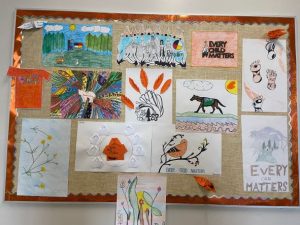Throughout my K-12 experience, we never really focused much on Indigenous history until I was in high school. We learnt a lot about residential schools but started thoroughly concentrating on indigenous history when the unmarked graves of the indigenous children were discovered. Once our country’s dark past was brought to light in the media, our classes started discussing it more. However, in my elementary experience, we barely ever talked about indigenous culture, and all we learnt about them was how they were the first people on our land. Still, nothing about the dark past Canada had with them. Land acknowledgements weren’t a thing until I was in high school, and that’s when I started learning more about Indigenous history. As an adult, I learned about residential schools and how they were stripped of their culture through the media and my high school classes. I learnt about how it impacted their culture and how it still resonates and affects them today. I now continue to learn more about the history I never learnt in years of schooling through media and discussions in my University classes.
The TRC booklet allows discussion of truth and reconciliation and understanding how this has affected their community and how discussing these issues is an essential topic for our youth as it is a massive part of our history. Not only do the students need to understand the past, but also the teachers need to be educated and open to discussing the topic in their classrooms. A message that resonates with me is that “the truth isn’t always comfortable, but we need the truth so we don’t make the mistakes again.” This is such a powerful statement. The
history of the Indigenous people is such a dark chapter in Canadian history, and in my schooling and in the media, it was often hidden because of how painful it can be to hear. Hiding the truth may seem better because of how terrible it was, but it is not. We need to understand past mistakes and help heal the community our country harmed.
In my field placement, it was refreshing and amazing to see the representation of the indigenous culture and its history. They had a board with artwork made by the students
 representing the “Every Child Matters” movement and had Treaty 4 flags all around the school and in the classrooms. When I was in school, we didn’t have this much representation placed around the school, which affected our ability to learn and discuss it. The teachers incorporating indigenous culture into their teaching helps the children learn by actively participating in the culture. During the placement, I was in a music class with a kindergarten class, and we played with jingle bells. This young indigenous girl beside me said to me, “these are just like the bells that are on my jingle dress,” and that was so heartwarming to hear that she is feeling represented in the music class and can reflect back onto her culture. This is important for the indigenous youth as they have been greatly unrepresented, and their history has been hidden from our school system and media. I asked the young girl about her jingle dress, and she was so excited to explain it to me and share her joy of dancing in it. This showed me how much even a simple thing like playing with some indigenous music items can bring comfort to students of that culture.
representing the “Every Child Matters” movement and had Treaty 4 flags all around the school and in the classrooms. When I was in school, we didn’t have this much representation placed around the school, which affected our ability to learn and discuss it. The teachers incorporating indigenous culture into their teaching helps the children learn by actively participating in the culture. During the placement, I was in a music class with a kindergarten class, and we played with jingle bells. This young indigenous girl beside me said to me, “these are just like the bells that are on my jingle dress,” and that was so heartwarming to hear that she is feeling represented in the music class and can reflect back onto her culture. This is important for the indigenous youth as they have been greatly unrepresented, and their history has been hidden from our school system and media. I asked the young girl about her jingle dress, and she was so excited to explain it to me and share her joy of dancing in it. This showed me how much even a simple thing like playing with some indigenous music items can bring comfort to students of that culture.
